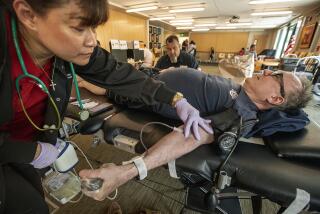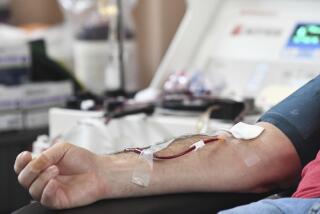What to Expect When Donating Blood
During the past 25 years, Sabu Dzinovic has helped collect blood from about 20,000 people, getting quite an education in the process.
He has seen cool-as-a-cucumber donors standing behind nail-biting ones. He has seen some donors watch the pint of blood flow into a collection bag, while others close their eyes before the needle even makes contact. And by now he knows a 250-pound man is more likely to faint than a woman half that size.
Based on that experience, Dzinovic--who is coordinator of the Blood Donor Center at Childrens Hospital, Los Angeles--has advice for novice donors who want to bolster the blood supply for troops in the Persian Gulf.
* Alert the person taking your blood if you have a history of lightheadedness or fainting so he or she can keep a close eye on you.
* To quell anxiety, take along a stereo headset and tune in to your favorite music while your blood is being collected.
* If you go with a group, don’t listen to others’ negative talk before donating. Such comments make “borderline” donors even more nervous.
* Remember, blood donations are negotiable. “The procedure can be stopped at any time,” Dzinovic says.
Those inspired by his advice shouldn’t just roll up their sleeves and drop in at the nearest Red Cross office. Dr. Steven Kleinman, a spokesman for the American Red Cross, suggests that you make an appointment.
Right now, the blood supplies are ample, he says, citing an overwhelming response to an initial plea for blood before the war started. But he encourages potential donors to make an appointment for the procedure, which takes about 45 minutes.
By spacing out donors, Kleinman explains, the Red Cross hopes to ensure adequate long-term supplies; the shelf life of each pint is just 42 days.
“It’s a minor stress to your body, so it would be helpful if people came rested and ate normally that day,” Kleinman says.
Before the pint is collected, a donor’s ear or finger is pricked and that blood is tested to rule out anemia. Potential donors are asked to complete a questionnaire about medical history and AIDS-related risk factors.
“We ask (potential donors) if they have been tested for HIV virus,” Kleinman says.
Potential donors who have tested HIV positive are turned down, as are those who have tested negative but belong to a high-risk group--intravenous drug users, homosexual men.
All blood collected is tested for HIV, hepatitis and other conditions.
Potential donors should “carefully consider all the risk questions, not just about AIDS, but hepatitis and malaria,” says Dr. James Mosley, a USC professor of medicine and director of the Transfusion Safety Study, a government-sponsored investigation. “(Only one) male homosexual contact is a reason not to show up for a blood donation,” he says.
The Red Cross requires that donors be at least age 17. They should weigh at least 110 pounds to reduce the risk of depleting their blood volume too much, Kleinman says.
After the blood is drawn, donors must rest for 15 minutes. They are encouraged to drink juice and have a snack. “We tell people they shouldn’t do activities that exert their arm muscles for about the next four hours,” Kleinman says. That rules out weightlifting or aerobic dance classes with intense arm exercises. “But a couple of hours later, you could probably go out running,” he says.
It takes two weeks for a body to fully replenish the red blood cells, Kleinman says, adding that most people won’t feel a difference in energy level or exercise performance during that time. Healthy people can donate blood every two months or so, experts say.
For an appointment to donate blood, call the Red Cross at (213) 739-5200 or (714) 835-5381, or Childrens Hospital at (213) 669-2441.
More to Read
Sign up for Essential California
The most important California stories and recommendations in your inbox every morning.
You may occasionally receive promotional content from the Los Angeles Times.










